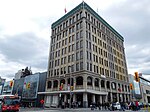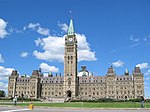Senate of Canada Building

The Senate of Canada Building (French: édifice du Sénat du Canada) is a government building and former railway station that serves as the temporary seat of the Senate of Canada. Located at 2 Rideau Street in downtown Ottawa, Ontario, it was known as Ottawa Union Station and served as the city's central railway station from 1912 until 1966. From 1966 to 2018, it was operated by the Government of Canada as the Government Conference Centre. The building currently includes a temporary Senate chamber, as well as some Senate offices and committee rooms. It is situated at the intersection of Wellington Street and the Rideau Canal, across the street from the Château Laurier hotel (which was constructed around the same time). It is 600 metres (2,000 ft) from Parliament Hill and Confederation Square.
Excerpt from the Wikipedia article Senate of Canada Building (License: CC BY-SA 3.0, Authors, Images).Senate of Canada Building
Rideau Street, (Old) Ottawa Rideau-Vanier
Geographical coordinates (GPS) Address External links Nearby Places Show on map
Geographical coordinates (GPS)
| Latitude | Longitude |
|---|---|
| N 45.424525 ° | E -75.693655 ° |
Address
Senate of Canada Building
Rideau Street 2
K1N 8W5 (Old) Ottawa, Rideau-Vanier
Ontario, Canada
Open on Google Maps








